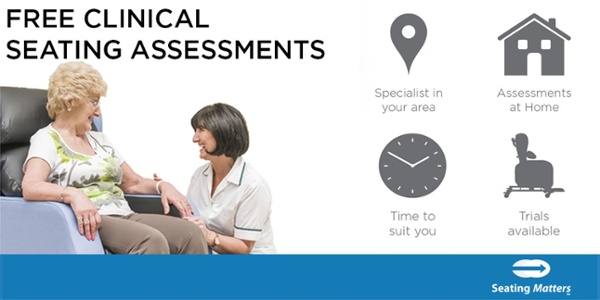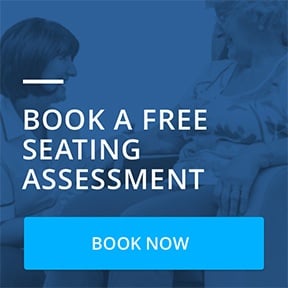If you, or someone you care for, is isolated either at home or in a care home due to Covid restrictions, you might be worried about mobility and keeping active, especially if exercise was a big part of your life prior to lockdown or isolation.
When you have limited space to exercise, it can be hard to be motivated to get up and move. But there are actually lots of ways you can strengthen your body and keep in shape without needing special equipment or large amounts of space. You can use everyday objects you have in your home to help get your heart rate up and build up strength. 
Here are some exercises that you, or someone you care for, can do at home with objects you may already have in the room around you;*
SIT TO STANDS
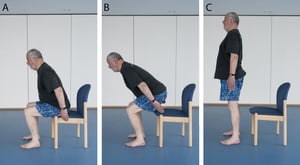 Such a simple activity, that we often do without thinking, has great benefits for leg strength when repeated.
Such a simple activity, that we often do without thinking, has great benefits for leg strength when repeated.
Start sitting on a sofa or chair and stand up, using arms for support if you need. Then repeat up to 10 times in a row.
Doing this 1-2 times daily will build up leg strength and improve balance. And the lower or softer the seat surface you stand up from, the harder you have to work to get up.
WALL OR TABLE PUSH UPS
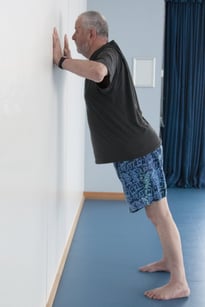 To work out your arms in a safe way in limited space, try wall push ups.
To work out your arms in a safe way in limited space, try wall push ups.
Stand with your feet together approximately 2-3 feet away from a wall or closed door. Bring your arms to shoulder height and width apart and with them outstretched, lean to the wall. Then from here, bend your elbows to bring yourself closer to the wall, making sure to keep your back nice and straight. Aim for 10-20 repetitions.
If that feels too difficult, step closer to the wall to start with less of a distance to cover and once you build up strength, move away. If it’s too easy, move to a high countertop or table so you have a bigger incline to make it harder to do.
CAN BICEP CURLS OR ROWS
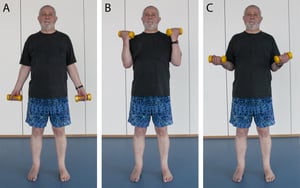 Find cans of soup or preserves (or anything of a similar weight) and with your elbows tucked into your sides, straighten and bend your elbows to do bicep curls.
Find cans of soup or preserves (or anything of a similar weight) and with your elbows tucked into your sides, straighten and bend your elbows to do bicep curls.
If you only have one, you can alternate sides, doing a cycle of repetitions (10) on one side and then switch to the other to give the first side a break.
You can also use books, rolled up towels and of course small hand weights if you have them available.
SQUATS
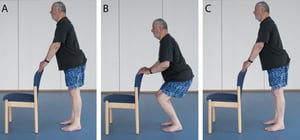 Standing next to something stable, hold on for balance, and with your feet hip width apart, squat down as if you are trying to sit on a chair.
Standing next to something stable, hold on for balance, and with your feet hip width apart, squat down as if you are trying to sit on a chair.
You should ‘sit back’ when doing a squat, as if you are lowering into a chair. If you want, you can do this in front of a chair so you have a target for how low you should go down. Make sure to look straight ahead and keep your back straight so you don’t strain your back.
SIDEWAYS LEG RAISES
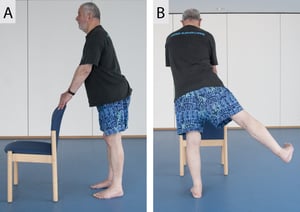 Just like with the squats, stand close to something stable you can hold on for balance, then, raise one leg out to the side, keeping the rest of your body from the waist up nice and straight – don’t bend to the other side to get your leg to go higher - and then slowly lower it down again.
Just like with the squats, stand close to something stable you can hold on for balance, then, raise one leg out to the side, keeping the rest of your body from the waist up nice and straight – don’t bend to the other side to get your leg to go higher - and then slowly lower it down again.
Try 10 on one side and then switch!
LAPS - AROUND THE ROOM OR HOUSE
Challenge yourself to get up during an ad break or every few hours and walk for 5-10 minutes. If you do nothing else during the day, this is the best thing you can do to get your heart rate up, improve or maintain mobility and strength and keep you fit.
To keep active, try to do at least one activity a day and do 2-3 sets of 10. Rotate through or do one upper body and one lower body activity a day to get a total body workout.
If you have access to the internet, there are a host of great videos on YouTube that cater to many different fitness levels to help keep you mobile during the day. Search for videos like “PE with Joe” or “Blogilates” to find workouts that are right for you!
References:
- NHS. (n.d.). Strength Exercises. Retrieved December 08, 2020, from https://www.nhs.uk/live-well/exercise/strength-exercises/
*Note - the purpose of this blog is to give an overview of the product with some tips to consider on its use. This is not intended to be a substitute for professional or medical advice, diagnosis, prescription or treatment and does not constitute medical or other professional advice. For advice with your personal health or that of someone in your care, consult your doctor or appropriate medical professional.




